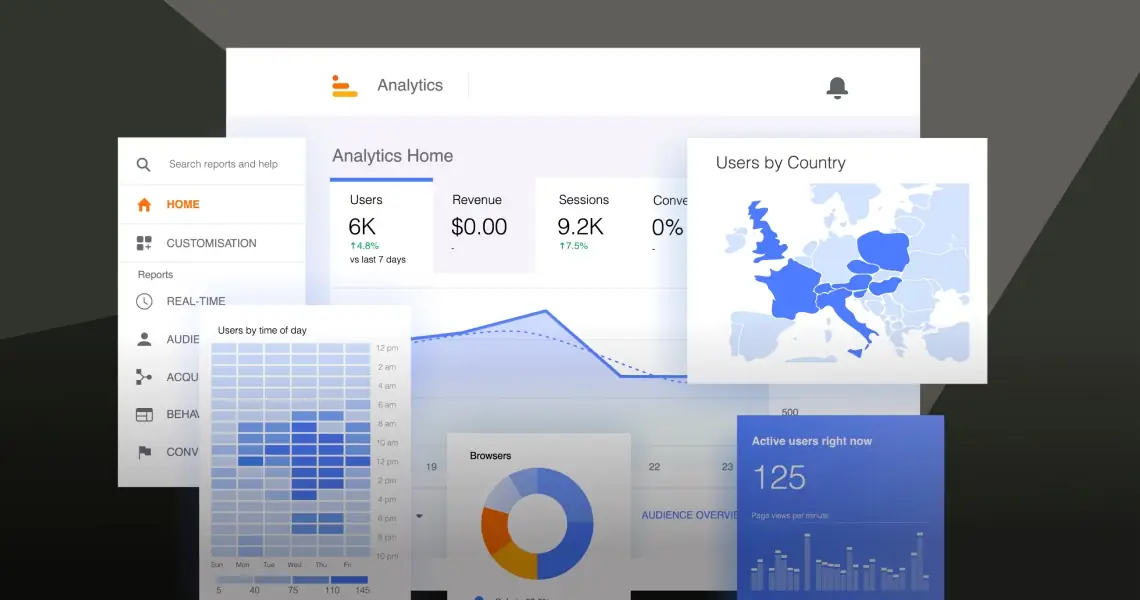
Google Analytics has always been the default whenever we’re talking about website tracking. For this reason, updates to this platform have always had an enormous impact on marketers. Enter Google’s recently launched version of Analytics, Google Analytics 4 (GA4). The newest update of Google Analytics will be the platform all future properties are built upon, so you’ll likely want to set it up as soon as possible for your sites.
Moving to a “privacy-first” tracking approach will likely cause some confusion at first. However, Google is promising a range of benefits, including accessing new tools, reports and functionality sooner, which will greatly support media strategy and future recommendations.
Google also promises increased functionality that will leave the old model, Universal Analytics (UA) in the dust, such as:

The main reason for the GA4 update is because tracking users through cookies and tags is coming to an end. Luckily, Google has announced that it won’t begin to block third-party cookies until late 2023, giving marketers a little breathing room before things entirely change. However, marketers should still consider creating a GA4 property now, so they’re fully prepared when tracking becomes more limited.
GA4 is less of an upgrade and more of a shift to an earlier property, Google’s App + Web. App + Web was not the major hit Google predicted, namely because of poor marketing (Most people didn’t think they would need “App” functionality, but a new version of Analytics hits a bit different).
That’s not to say GA4 is a repackaging of an old solution. Tracking site visits and user behavior is getting tricky. Regulations, restrictions, updates, blockers, and more are forcing us to evolve. Google claims that GA4 will be the definitive “future-proof” solution to analyzing website data.
GA4 will use “privacy-first” tracking, which leverages machine learning models to fill gaps in tracking caused by upcoming privacy and tracking restrictions.
GA4 includes a bevy of new features that promise to be the future of analytics. The platform will allow marketers to dive deeper into data without cookies and other tracking components that will eventually become obsolete.
One major benefit of GA4 is the integration of AI, which promises a more user-friendly customer experience. Users will have an easier time finding answers to questions through streamlined reporting. For example, you can simply ask GA4 to give you data on, say, how many users in Europe viewed your homepage at 6 am, versus applying multiple filters to create a specialized report.
However, AI will primarily be used to produce better insights and predictions by extrapolating data to make assumptions about website traffic and user behavior. As these tracking components, like cookies, become increasingly scarce, GA4’s AI will supplement that data to fill the gap left by upcoming privacy restrictions.
GA4’s user interface has been completely redesigned to include new sections such as Engagement, Monetization, Retention, Analysis, and more. Also, there is no more View Level. Everything will be controlled at Property Level, consolidating data from websites and mobile apps into a single report for cross-platform analysis.
Since GA4 was built off the foundation of Google’s Web + App property, it retains much of the cross-functionality that platform was designed for.
GA4 now focuses on customer journeys rather than individual metrics. Lifecycle reports can give insights into the exact location of customers within the sales funnel at a far more granular level. GA4 tracks customer behavior across both websites and apps, connecting multiple data streams to provide a fuller picture across devices.
Full reporting across multiple devices will also eliminate duplicate data across devices by measuring a single user journey utilizing multiple identifiers.
Tracking will provide more flexibility under GA4. For one, basic events such as Page View, Session Start and Scroll are ready to track right out of the box. This will provide marketers who may not be tech-savvy access to their most basic tracking needs without additional coding.
You can also create and edit events directly in the platform and apply up to 25 parameters using any name you choose.
In life, there are three certainties: death, taxes, and software updates. While GA4 will undoubtedly be the future of analytics tracking, there are always challenges in implementing new technology and systems into your business. Anytime you adopt a new platform at launch, your employees are bound to experience some bugs and loss of familiar functionality.
For example, adopting GA4 now may mean that data will not perfectly match up between platforms. Some people are reporting lower sessions in GA4, which may be confusing to marketers who are used to UA. GA4 users have also reported a delay in data processing, with GA4 taking 72 hours to process versus the 4 hours it took UA to do the same.
Fully adopting GA4 will require educating your team and determining how best to use this platform for your individual business and marketing purposes. For this reason, you may want to hold on to UA and use it in parallel with GA4 for the time being. Even if you are using GA4 as your default, you can still create a UA property by following a few steps.
By using both platforms simultaneously, you can get all the benefits of both platforms as bugs and functionality issues are ironed out in future updates.

For client work, make sure to connect and educate your client about GA4. We recommend implementing new GA4 tags on client websites. You can then create a new GA4 property to start populating data. At the onset, both instances of Google Analytics (UA & GA4) will be collecting data. Your team can then slowly move away from UA over time once you have sufficient data in GA4 property (Approximately 13+ months). Keep in mind, the data in GA4 is not retroactive, so it’s important to get new properties set up now for each of your clients.
Google Analytics 4 (GA4) has officially been rolled out and is here to stay. With a wealth of new available features, reports, and data tracking/modeling capabilities, it’s paramount for businesses to create a GA4 property as soon as possible to begin data collection of website visitors. With constantly changing technology, an agency built for change will lead the way.